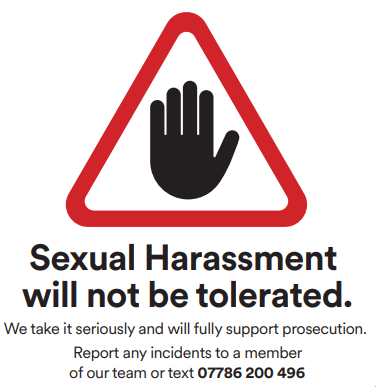Project Safe Place
What is Project Safe Place?
At National Express we are always looking at how we can ensure that passengers are safe on our services and in coach stations and recognise the importance of preventing incidents of harassment of any kind.
‘Project Safe Place’ focuses on the issue of sexual harassment across the National Express coach network. The first phase is a visual campaign on board our vehicles and in our coach stations and has been designed to send a clear and strong message that sexual harassment will not be tolerated and we will always fully support prosecution.
The primary target is would-be perpetrators of sexual harassment with the objectives to clearly communicate National Express’ zero tolerance approach and to raise awareness of the likelihood of prosecution. This is reinforced with details of how to report incidents of sexual harassment.
Alongside the visual campaign, the project programme includes specific training for our drivers, Customer Service Advisors, and call handlers. They are trained on what sexual harassment is, how to handle incidents and providing follow-up support to those who have been subjected to sexual harassment on our network, as well as strongly supporting prosecution of the perpetrator.
What is sexual harassment?
While sexual harassment is usually thought of as male on female, it can happen across all genders and can take a number of different forms, including:
- Unwanted touching or physical contact
- Sexual advances
- Physical assault
- Language and jokes of a sexual nature
- Commenting on a person's physical appearance
- Asking inappropriate personal questions
- Circulation or showing of sexually explicit images, texts, or video material
- Openly discussing sexual experiences or fantasies
- Unwanted staring
None of these behaviours will be tolerated on our services or in our Coach Stations.
Actions you can take if you experience sexual harassment on our network
We want to ensure incidents of this nature don’t happen but if they do, it’s important that we provide the appropriate support.
If you experience sexual harassment on our network, you should:
- If possible, take yourself to a safe place. Get away from the perpetrator and distance yourself as much as you can.
- If you are on a coach, text our text feedback number: 07786 200 496 our team will respond and inform the driver that they need to intervene.
- Report the incident to a member of our team, whether that be the driver of your coach or a Customer Service Advisor in one of our coach stations. Our teams are on hand to help and will support you in any way possible.
- In an emergency, call 999.


After Support
We hope you will share your contact details with a member of our team so our customer service team can get in touch to check how you are and ask if you need any further support.
At this time, it is also important that if you can, you reach out to friends and family and speak about how you are feeling. You should not face this alone.
There are also various support services available if you need to speak to someone. Please visit the NHS website for further information and advice.
